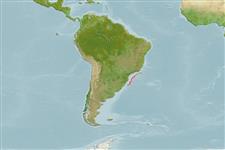Olocefali (chimere) (chimaeras) >
Chimaeriformes (Chimaeras) >
Chimaeridae (Shortnose chimaeras or ratfishes)
Etymology: Hydrolagus: hydro-, combining form of hydor (Gr.), water; lagos (Gr.), hare, i.e., “water rabbit,” probably referring to three pairs of tooth plates, which tend to protrude from the mouth like a rabbit’s incisors (See ETYFish); matallanasi: In honor of Jesús Matallanas Garcia, University of Barcelona (Spain), for his “extensive work and tireless dedication to ichthyology” (See ETYFish).
Eponymy: Jesús Matallanas Garcia is a Spanish ichthyologist and Professor in the Faculty of Biosciences at the University of Barcelona. [...] (Ref. 128868), visit book page.
Environment: milieu / climate zone / depth range / distribution range
Ecologia
marino batidemersale; distribuzione batimetrica 416 - 736 m (Ref. 52554). Subtropical; 23°S - 31°S (Ref. 52554)
Distribuzione
Stati | Aree FAO | Ecosystems | Presenze | Point map | Introduzioni | Faunafri
Southwestern Atlantic: Brazil.
Length at first maturity / Size / Peso / Age
Maturity: Lm ?, range 30 - ? cm
Max length : 69.5 cm TL maschio/sesso non determinato; (Ref. 52554); 37.8 cm OT (female)
Short description
Chiavi di identificazione | Morfologia | Morfometria
Diagnosis: Differs from its congeners in having an irregular brown coloration with reticulations and spots over the body; ventral surface whitish, including pectoral bases; proximal margin of the second dorsal fin whitish; tooth plates striped and bicolor, yellowish and gray; length of dorsal fin spine equal to or slightly greater than head length; pectoral fin notably long, its tip extending beyond posterior margin of pectoral fin base; upper margin of second dorsal fin notably concave at middle region of second dorsal fin base; minimum height of second dorsal fin less than half of maximum height (located at points anterior and posterior to middle region of fin); eye length slightly smaller than preorbital length (Ref. 52554).
Female maximum length given as precaudal length (PCL). Inhabits deep-reefs on the continental slope, usually deeper than 400 meters; with gorgonians, hard corals, tube sponges, crinoids, and ophiuroids. It also shares this habitat with other sharks Heptranchias perlo, Scyliorhinus haeckelii, Galeus mincaronei, Schroederichthys saurisqualus, Squalus sp., and the skate Gurgesiella dorsalifera (Ref. 52554).
Life cycle and mating behavior
Maturità | Riproduzione | Deposizione | Uova | Fecundity | Larve
Soto, J.M.R. and C.M. Vooren, 2004. Hydrolagus matallanasi sp. nov. (Holocephali, Chimaeridae) a new species of rabbitfish from southern Brazil. Zootaxa 687:1-10. (Ref. 52554)
IUCN Red List Status (Ref. 130435: Version 2024-2)
Threat to humans
Harmless
Human uses
Pesca: di nessun interesse
Strumenti
Special reports
Download XML
Fonti Internet
Estimates based on models
Preferred temperature (Ref.
123201): 6.4 - 10.2, mean 8.2 °C (based on 7 cells).
Phylogenetic diversity index (Ref.
82804): PD
50 = 0.5000 [Uniqueness, from 0.5 = low to 2.0 = high].
Bayesian length-weight: a=0.00331 (0.00137 - 0.00798), b=3.07 (2.86 - 3.28), in cm total length, based on LWR estimates for this (Sub)family-body shape (Ref.
93245).
Trophic level (Ref.
69278): 3.8 ±0.6 se; based on size and trophs of closest relatives
Resilienza (Ref.
120179): Basso, tempo minimo di raddoppiamento della popolazione 4.5 - 14 anni (Assuming fecundity<100).
Fishing Vulnerability (Ref.
59153): Moderate to high vulnerability (48 of 100).
